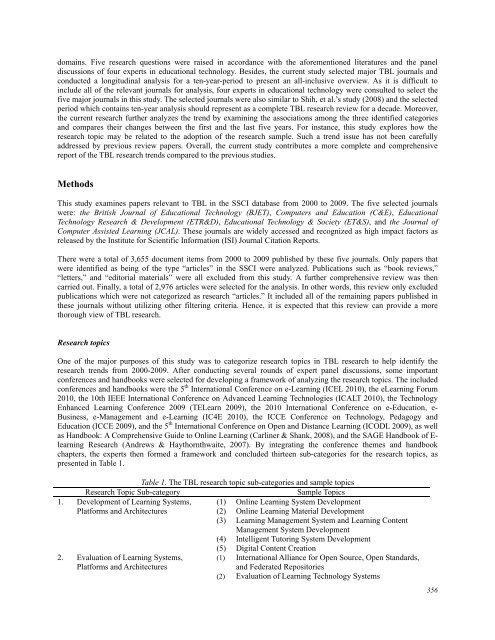April 2012 Volume 15 Number 2 - Educational Technology & Society
April 2012 Volume 15 Number 2 - Educational Technology & Society
April 2012 Volume 15 Number 2 - Educational Technology & Society
You also want an ePaper? Increase the reach of your titles
YUMPU automatically turns print PDFs into web optimized ePapers that Google loves.
domains. Five research questions were raised in accordance with the aforementioned literatures and the panel<br />
discussions of four experts in educational technology. Besides, the current study selected major TBL journals and<br />
conducted a longitudinal analysis for a ten-year-period to present an all-inclusive overview. As it is difficult to<br />
include all of the relevant journals for analysis, four experts in educational technology were consulted to select the<br />
five major journals in this study. The selected journals were also similar to Shih, et al.’s study (2008) and the selected<br />
period which contains ten-year analysis should represent as a complete TBL research review for a decade. Moreover,<br />
the current research further analyzes the trend by examining the associations among the three identified categories<br />
and compares their changes between the first and the last five years. For instance, this study explores how the<br />
research topic may be related to the adoption of the research sample. Such a trend issue has not been carefully<br />
addressed by previous review papers. Overall, the current study contributes a more complete and comprehensive<br />
report of the TBL research trends compared to the previous studies.<br />
Methods<br />
This study examines papers relevant to TBL in the SSCI database from 2000 to 2009. The five selected journals<br />
were: the British Journal of <strong>Educational</strong> <strong>Technology</strong> (BJET), Computers and Education (C&E), <strong>Educational</strong><br />
<strong>Technology</strong> Research & Development (ETR&D), <strong>Educational</strong> <strong>Technology</strong> & <strong>Society</strong> (ET&S), and the Journal of<br />
Computer Assisted Learning (JCAL). These journals are widely accessed and recognized as high impact factors as<br />
released by the Institute for Scientific Information (ISI) Journal Citation Reports.<br />
There were a total of 3,655 document items from 2000 to 2009 published by these five journals. Only papers that<br />
were identified as being of the type “articles” in the SSCI were analyzed. Publications such as “book reviews,”<br />
“letters,” and “editorial materials” were all excluded from this study. A further comprehensive review was then<br />
carried out. Finally, a total of 2,976 articles were selected for the analysis. In other words, this review only excluded<br />
publications which were not categorized as research “articles.” It included all of the remaining papers published in<br />
these journals without utilizing other filtering criteria. Hence, it is expected that this review can provide a more<br />
thorough view of TBL research.<br />
Research topics<br />
One of the major purposes of this study was to categorize research topics in TBL research to help identify the<br />
research trends from 2000-2009. After conducting several rounds of expert panel discussions, some important<br />
conferences and handbooks were selected for developing a framework of analyzing the research topics. The included<br />
conferences and handbooks were the 5 th International Conference on e-Learning (ICEL 2010), the eLearning Forum<br />
2010, the 10th IEEE International Conference on Advanced Learning Technologies (ICALT 2010), the <strong>Technology</strong><br />
Enhanced Learning Conference 2009 (TELearn 2009), the 2010 International Conference on e-Education, e-<br />
Business, e-Management and e-Learning (IC4E 2010), the ICCE Conference on <strong>Technology</strong>, Pedagogy and<br />
Education (ICCE 2009), and the 5 th International Conference on Open and Distance Learning (ICODL 2009), as well<br />
as Handbook: A Comprehensive Guide to Online Learning (Carliner & Shank, 2008), and the SAGE Handbook of Elearning<br />
Research (Andrews & Haythornthwaite, 2007). By integrating the conference themes and handbook<br />
chapters, the experts then formed a framework and concluded thirteen sub-categories for the research topics, as<br />
presented in Table 1.<br />
Table 1. The TBL research topic sub-categories and sample topics<br />
Research Topic Sub-category Sample Topics<br />
1. Development of Learning Systems, (1) Online Learning System Development<br />
Platforms and Architectures<br />
(2) Online Learning Material Development<br />
(3) Learning Management System and Learning Content<br />
Management System Development<br />
(4) Intelligent Tutoring System Development<br />
(5) Digital Content Creation<br />
2. Evaluation of Learning Systems, (1) International Alliance for Open Source, Open Standards,<br />
Platforms and Architectures<br />
and Federated Repositories<br />
(2) Evaluation of Learning <strong>Technology</strong> Systems<br />
356

















